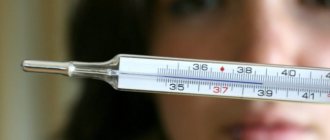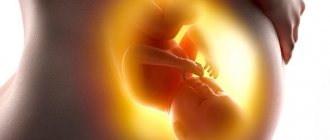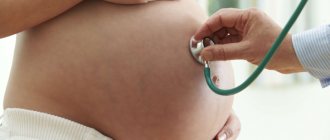What should be the temperature when breastfeeding?
If a nursing mother immediately after feeding or pumping measures her armpit temperature, she will find that it is higher than normal. Typically, you can see values on the thermometer in the range of 37.0-37.4 ° C. This is absolutely normal, since after feeding, the muscles release heat, in addition, the temperature of the milk in the ducts is above 37 ° C. Accordingly, to obtain reliable results, doctors do not recommend measuring the temperature under the armpit.
Temperature and lactation
How to recognize and not confuse it with seizures?
Chills are characterized by small, constant muscle contractions. The child experiences a feeling of cold . Children who can speak like this say: “I’m cold.” At the same time, they try to wrap themselves up warmly, huddling into a ball, trying to minimize heat transfer.
Cramps are periodic muscle contractions with large amplitudes , which consciousness cannot control.
During cramps , one part of the body may be involved, that is, arm, leg, shoulder, etc., twitch rhythmically. Very rarely, a convulsive spasm affects all muscles.
In this case, the baby's eyes roll back, and waves of contractions .
If the attack does not stop after three to five minutes, the child loses consciousness .
Chills can turn into seizures in some cases, so parents need to know how fevers develop and what they might mean.
Reasons for changes in a woman's body temperature during breastfeeding?
The physiological increase in temperature is due to the process of milk formation. In addition, at the beginning of lactation it is not established. Accordingly, the chest may become full and sore from stretching. This process is also accompanied by an increase in temperature. But if the temperature rises above 37.6 °C, you should look for other reasons. This temperature is not normal and may be a symptom of a dangerous disease.
Temperature during lactation
Useful video
We invite you to watch a video about the causes of fever during breastfeeding and feeding rules during this period:
Naturally feeding a baby today is considered the priority way of feeding it. It is breast milk that provides the baby with all the substances necessary for development and growth. According to the standards of the World Health Organization, from birth to six months, only such food should be present in the baby’s diet.
Most modern mothers are willing to master the art of lactation, which was undeservedly neglected by many during the Soviet years. However, every responsible family and attentive parents have a number of questions related to the safety of the feeding process for the child. One of them is the temperature of a nursing mother.
During lactation, a woman’s body spends a lot of energy and nutrients on the health and growth of the baby. Therefore, a nursing mother, like no one else, is susceptible to viral attacks and inflammatory processes. Many of them are accompanied by an increase in temperature.
What to do, how to treat it, whether to knock it down or not - you need to know the answers to all these questions. But in order to understand what to do and what to drink for a nursing mother’s temperature, it is worth understanding the reasons for its increase.
How to measure temperature correctly while breastfeeding?
If you measure your temperature under your armpit, you will get an unreliable result. When breastfeeding, the thermometer always reads more than 37 °C. This is normal, so to obtain adequate and true values, place the thermometer in the crook of your elbow. Simply hold the thermometer with your hand bent. In the maternity hospital they measure in the inguinal fold or even in the mouth. True, the temperature in the mouth is also normally higher than 37 °C.
If you suspect you have breast problems, take the temperature under both armpits. It may vary, but if it is higher than 37.6 °C, we can talk about some kind of disease.
Temperature at hot water
Thermometer error
This phenomenon occurs in the first months of a child’s life if the nursing mother has a lot of milk. Often the temperature rises when the milk just “comes in” and the breasts become painfully full.
The error in thermometry lies in the fact that the temperature under the armpit is slightly higher than the oral, rectal or elbow temperature. This is due to the abundance of milk and the fact that the breasts are still getting used to their new state. If the thermometer shows no more than 37, then there’s no need to worry about how to bring down the temperature of a nursing mother - there’s simply no need to do this. Usually after feeding everything returns to normal.
To avoid this error, measure the temperature of nursing mothers correctly at the bend of the elbow. This method is often used in maternity hospitals, reminding mothers not to place the thermometer under the armpit.
Is it possible to breastfeed at a fever?
This is a separate issue, since previously the mother was taken away from the baby and forbidden to breastfeed. Now everything has changed, and in most cases, if the mother does not take any serious medications, feeding the baby is not only possible, but necessary.
If the mother has ARVI, there is no need to stop lactation; it is enough to wear a mask and try to spend less time with the child so as not to infect him. You can express milk and give it to your baby from a bottle. In case of lactostasis, that is, blockage of the milk ducts, there is no need to stop feeding. The baby will remove milk from the inflamed area better than any breast pump. Many mothers are afraid of the salty taste of milk when they have lumps in the breast. This is as it should be, because at the same time sodium salts approach the breast tissue, and the taste of the milk changes.
The salty taste of milk has nothing to do with the appearance of pus in it. If the milk is of normal color and has a salty taste, you can feed the baby. Moreover, it is better to do this only from the sore breast. Milk is expressed from a healthy mammary gland.
Lactostasis and feeding
General concept
In most cases, chills are a protective reaction of the body to prevent hypothermia .
This phenomenon is accompanied in children:
- The appearance of “goose bumps” due to spasm of blood vessels located on the surface of the body. This is how the body protects itself from dehydration by limiting evaporation.
- Trembling muscles (to increase the body's heat production). First of all, the masticatory muscles begin to contract, that is, “teeth chatter.”
- The desire to curl up into a ball (take the fetal position).
Chills are accompanied by increased metabolism and increased synthesis of interferons, that is, the body comes into a state of combat readiness, mobilizing all its defenses.
Increased temperature during breastfeeding, causes
There are many reasons for rising temperatures. It is not necessarily some kind of dangerous disease. Most likely, this is lactostasis or a common ARVI.
Reasons for increased temperature during lactation:
- Inflammatory processes after cesarean section
- Poisoning
- ARVI
- Mastitis or lactostasis
- Endometritis
If you suspect that there may be some tissue left inside the uterus after childbirth, contact your gynecologist immediately. If not treated promptly, blood poisoning and even death may occur. As practice shows, women with endometritis after childbirth rarely consult a gynecologist on their own. They are taken away by ambulance due to the temperature rising to 40°C. Do not put stitches in your abdomen after a caesarean section. If they constantly pull, hurt, or ooze pus, consult a doctor.
Reasons for the increase in temperature during hot water
Causes
In children, short-term fever may occur when hypothermia occurs in a state of immobility. It goes away instantly if the child is changed into dry clothes and warmed up by giving him a warm, sweet drink.
Also, chills without fever can develop as a result of:
- Nervous tension, severe stress.
- Intoxication of the body (acute respiratory infections, intestinal infection, inflammation of the lungs and genitourinary system, tuberculosis often occurs at normal or slightly elevated temperature).
- Taking medications (for example, fluoroquinolone antibiotics).
- Vaccinations, Mantoux reactions.
- General exhaustion of the body after a long illness, intense exercise (sports competitions and preparation for them) or due to vitamin deficiency.
- Vegetative-vascular dystonia (typical for adolescents).
- Increased intracranial pressure (up to a year).
- Malfunction of the endocrine system. Here we can distinguish hypothyroidism (decreased production of thyroid hormones) and type 1 diabetes, which becomes more active during puberty.
More rare causes of chills in children include:
- Renaud's syndrome is a lesion of small vessels on the tips of the fingers and toes, as well as the nose and earlobes.
- gastritis (acute and chronic). In this case, chills may be accompanied by bad breath.
- hypopituitarism is a decrease in the production of hormones by the pituitary gland.
In any case, every parent should be able to recognize the appearance of chills in the baby, provide him with first aid, and if attacks continue or recur (without hypothermia), without delay, consult a doctor .
How to raise your temperature while breastfeeding?
It is advisable not to prescribe anything to yourself. To raise your temperature, you need to get a good night's sleep and rest. After all, the cause of low temperature is overwork. In addition, it is worth taking a hemoglobin test. If the temperature is caused by a low hemoglobin concentration, take iron supplements, for example Maltofer. It is safe and can be taken while breastfeeding. A diet to increase hemoglobin is welcome. Eat buckwheat porridge, boiled beet liver and baked apples.
Low lactation temperature
How to lower your temperature while breastfeeding?
If the temperature appears suddenly, you can take Ibufen or Paracetamol. These medications are approved even for children, so there is no need to stop feeding your child. Many mothers refuse to take any medications for breastfeeding; this is wrong, as you will make things worse for yourself and your child.
You cannot take any antibiotics on your own. They may harm the baby. Any antibacterial and antiviral drugs can only be prescribed by a doctor.
Means for reducing fever
What do chills and fever indicate during breastfeeding?
First you need to determine what caused the temperature. If this is lactostasis, then you will feel characteristic chest pain and tightness. The chest will seem to “burn.”
- To reduce the temperature, just take a warm shower and massage your breasts, it can be very painful, but be patient, otherwise you risk missing a lump. After this, press on the mammary gland in the direction from the armpit to the nipple
- There is no need to press on the areola. You must release the distant lobules, which are the worst to be emptied
- After this, the cabbage leaf is beaten with a hoe and cooled in the refrigerator. Place this compress on your chest
- We constantly place the baby on the sore breast. If it is very bad, you can take Ibufen or Paracetamol
- If you do not feel pain in the chest, the glands are not hot and not stone-like, then most likely the reason is not lactation. Pay attention to your general health. If you have a headache, aching back and muscle weakness, then most likely you have a cold. This is a banal ARVI
- If you have a stomach ache or increased discharge after childbirth, call an ambulance immediately
Chills during breastfeeding
What to do if a nursing mother has a fever
Elevated body temperature is a surprise for a nursing mother. No matter how a woman tries to protect herself, in the postpartum period the female body is very vulnerable. There are many reasons for this condition.
It is important for a young mother to decide on further feeding of the child, because the baby needs food every 2-3 hours. The first step is to find out the true cause of this condition.
Reasons for rising temperature
The most common cause of illness is a viral and bacterial infection that enters the mother's body through air, food and water. In the autumn-winter period, there is a peak incidence of respiratory infections such as influenza and ARVI. If a young mother catches a bacterial or viral infection, then the risk of infecting her newborn baby is very high.
It is strictly forbidden to refuse breastfeeding against the background of ARVI, since valuable immune compounds enter the newborn’s body along with mother’s milk, which form the child’s body’s resistance to viral or bacterial infection. Thanks to such antibodies, the baby's risk of infection is reduced. If a baby becomes infected from his mother, the disease will develop in a mild form in his body.
The following factors can cause an increase in body temperature in a nursing woman:
- congestion in the mammary glands (lactostasis) and purulent-inflammatory process (mastitis);
- bacterial infection of the oropharynx and nasopharynx (sore throat, tonsillitis, sinusitis);
- exacerbation of chronic diseases of internal organs;
- dehiscence or inflammation of sutures placed after a cesarean section;
- food poisoning;
- inflammatory process in the endometrium of the uterus;
- other serious pathologies of internal organs.
Any disease that causes a rise in body temperature must be treated under the strict supervision of a medical specialist. The question of the advisability of continuing breastfeeding is decided by the attending physician after a preliminary examination. Many medications are strictly contraindicated during lactation, so you can forget about self-medication.
Violation of the technique of attaching a child to the breast provokes the development of congestion. If the mammary glands are not emptied in a timely manner, then inflammation forms in the stagnant focus, manifested in the form of increased body temperature.
The effect of elevated temperature on milk quality
The most pressing issue for a young mother is the quality and safety of breast milk at elevated body temperatures. This is very important, since poor quality nutrition causes serious harm to the fragile body of a newborn child.
With the development of a purulent-inflammatory process, pathogenic microorganisms can penetrate through breast milk into the baby’s body. If this happens to a young mother, she is advised to stop breastfeeding for a while. To prevent milk from wasting, it should be expressed regularly.
If the cause of this state of the body is lactostasis, then in the initial stage of the disease no qualitative changes in mother’s milk are observed. During this period, you should not stop breastfeeding, as this process will help the baby stay full and relieve the young mother of congestion.
Acute infectious diseases do not contribute to changes in the quality of breast milk. Along with milk, valuable antibodies enter the newborn’s body, forming the infant’s immunity.
To feed or not to feed
To answer this question, a young mother must verify the cause of this condition. You can continue breastfeeding in the following cases:
- if the cause of the rise in temperature was an acute respiratory viral infection (ARVI and acute respiratory infections);
- if the temperature has increased due to congestion and mastitis without a purulent process;
- if high body temperature is not accompanied by signs of a purulent-inflammatory process in the mammary glands.
It is recommended to temporarily stop breastfeeding in the following cases:
- if a staphylococcal infection is present in the mammary glands of a nursing mother;
- if the cause of the increase in body temperature is mastitis, complicated by a purulent-inflammatory process;
- if a young mother has worsened chronic diseases of internal organs.
If a young mother was forced to interrupt breastfeeding, then in order to maintain healthy lactation, she is recommended to constantly express milk and carefully monitor the hygiene of the mammary glands. There are good reasons for maintaining adequate feeding, which include:
- Mother's milk is a unique product that can provide the newborn's body with the necessary substances. Even a significant increase in the mother’s body temperature does not contribute to the souring and curdling of milk.
- With influenza and ARVI, the mother's body produces a large number of valuable antibodies, which enter the body of the newborn baby through food. This moment is very important for a child during the first year of life, since during this period the active formation of immunity occurs.
- When the body temperature is elevated, the woman becomes weak, and it is much easier for her to attach the baby to the breast in a comfortable position than to get up several times a day to express milk. The pumping procedure is tedious.
Even diseases caused by infectious pathogens cannot cause interruption of feeding if safe medications have been selected for the young mother.
How to measure temperature correctly
Correct measurement of body temperature affects the reliability of the indicators. The rush of breast milk in the mammary glands contributes to an increase in body temperature, so measuring it in the armpit gives a false result.
During the first 2 months after the birth of a child, a young mother should measure her body temperature in the elbow area. The normal temperature range is from 36.4 to 37.3 degrees.
How to bring down the temperature
If the cause of this condition has been established, then the primary task is to determine the feasibility of reducing it. If the temperature needs to be reduced, then the woman should choose only safe medications that cannot harm the baby’s body.
A safe way to reduce fever are rectal antipyretic suppositories containing Paracetamol and Ibuprofen. These substances are not able to enter mother's milk. Young mothers are often prescribed antipyretic drugs used in pediatric practice. Such medicines have a gentle effect on the female body and quickly reduce the temperature by several degrees.
A cool compress on the forehead will help bring down the temperature without medication. You can use a primitive method, which consists of rubbing the body with a solution of vinegar and water in a ratio of 1:3.
If you feel unwell, it is very important for a nursing mother to follow the correct drinking regime. The daily volume of fluid should be 1.5-2 liters. You should drink plain and mineral water, fruit juices, compotes and fruit drinks. Warm tea with lemon has an antipyretic effect. You can drink tea with viburnum or raspberry jam. The use of such products must be agreed with your doctor. If the baby has a tendency to allergies, then the woman should refrain from eating certain foods.
Nutrition in this condition should be varied and nutritious. You should eat food often and in small portions. It is important to avoid physical and emotional stress.
A nursing mother is strictly forbidden to fight fever on her own. If a woman feels unwell, she should seek advice from a medical specialist who will select the necessary treatment without the risk of harming the baby.
vskormi.ru
High fever while breastfeeding
A very high temperature during breastfeeding can be caused by purulent mastitis. This disease is accompanied by chest pain. When you press on the gland, you feel pain. Redness and dents after pressure do not resolve for a long time.
- Be sure to taste the milk and evaluate its color. If it turns greenish and has an unpleasant, purulent taste, express it and throw it away. You can't feed it to your baby
- For mastitis, antibiotics are prescribed; in advanced cases, surgery may be necessary.
Chills during breastfeeding
Postpartum thrombophlebitis
It is worth carefully understanding the reasons that can cause a high temperature in a nursing mother - we will try to understand what to do, what to do.
Postpartum thrombophlebitis may also be to blame. This is an inflammation of the venous wall, accompanied by the appearance of blood clots in the lumen of the vessel.
This disease is characterized by the following symptoms:
- weakness, malaise;
- temperature 37-38 degrees;
- nagging pain in the leg;
- redness and swelling of the skin, sometimes, with a deep form of thrombophlebitis, the thigh increases in size.
For this disease, anticoagulants, venoprotectors, and antiplatelet agents are usually prescribed. The doctor will most likely prescribe non-steroidal ointments against inflammation (for example, Diclofenac). Stopping breastfeeding is indicated only in extreme cases.
How to reduce a high temperature while breastfeeding?
Information about medications can be found above. But if you don't want to take anything, try lowering your temperature without medication:
- If you feel very hot, take off your clothes. Place a cloth soaked in vinegar solution on your head and calves. You can simply wipe yourself with cold water
- If you have chills and are very cold, dress warmly and lie under a warm blanket. You need to sweat. To do this, drink warm tea
- Drink linden and chamomile tea. You need to drink a lot of liquid
Reducing the temperature
How to reduce a high temperature while breastfeeding: tips
- Do not stop breastfeeding when the temperature rises. Many mothers believe that milk burns out at high temperatures, but in fact this is not the case.
- Your milk supply may decrease, this is normal.
- To stimulate lactation, put your baby to the breast more often
- If you have hepatitis B, you can take penicillin antibiotics
- You cannot take tetracycline and chloramphenicol. These drugs affect hematopoiesis and are prohibited during hepatitis B
Reducing the temperature
Do not self-medicate. If the temperature rises sharply, contact a specialist.
When should lactation be stopped?
Most diseases do not pose a risk to the baby, and lactation can continue. However, there are a number of diseases in which feeding will need to be interrupted for a while. These include:
- pneumonia;
- purulent sore throat;
- purulent mastitis;
- cystitis;
- severe form of intestinal infection;
- dysentery.
Due to the serious condition of the mother with such diseases, milk production may decrease, but it still requires a sufficient amount of energy. Therefore, first of all, treatment is necessary. A significant increase in temperature is caused by bacterial infections that are treated with antibiotics.
By themselves, they are rarely compatible with lactation and can cause allergies and dysbacteriosis. Diseases are also dangerous for the baby due to toxins that penetrate into the milk. For a newborn baby, this will have a detrimental effect on the condition.











